MSFC Noble-Gas Research Laboratory (MNGRL)
Noble-gas isotopes are a well-established technique for providing detailed temperature-time histories of rocks and meteorites. In the MNGRL lab we use Ar-Ar and I-Xe radioactive dating to find the formation age of rocks and meteorites, and Ar/Kr/Ne cosmic-ray exposure ages to understand when the meteorites were launched from their parent planets.


Last Modified: March 8, 2016
Web Services provided by Bob Dean (MITS)
NASA Official: Barbara Cohen
Complete system automation and instrument communications using the Mass Spec software package written by Al Deino of the Berkeley Geochronology Center. This software is in wide use in Ar-Ar labs, providing for an integrated system control, data collection, and data reduction package.
MNGRL Projects
The MNGRL lab was designed to study diverse
problems in planetary science. Current projects include:
-
•Early impact history of the Moon through 40Ar-39Ar dating of impact-melt lithologies in lunar meteorites, crystalline lunar spherules, and Apollo 16 breccias (e.g., Cohen et al., 2000).
-
•Impact history of the asteroid belt by examination of howardites, polymict ureilites, and brecciated chondrites, regolith breccias from large main-belt asteroids (e.g., Cohen 2007).
-
•Age limits on the Santa Fe impact crater and diffusion patters within the shock-affected rocks (e.g., Newsom et al., 2007)
-
•40Ar-39Ar ages and thermal history of unusual meteorites such as the ungrouped achondrites Graves Nunatak (GRA) 06128 and GRA 06129 (e.g., Park et al., 2010)
-
•Future applications may include measuring cosmogenic nuclides (e.g., 21Ne, 38Ar) to constrain exposure ages of meteorites in space, and I-Xe dating of aqueous alteration phases in martian and other meteorites.
If you are interested in collaborative use of the MNGRL lab, please contact us!
MNGRL Acknowledgements
The MSFC Noble Gas Research Laboratory is a NASA Regional Facility, built with funding contributions from the MSFC Technology Investment Program, the MSFC Science and Missions Systems Directorate, and the NASA Planetary Major Equipment Program, and is sustained with competitive research grants through NASA Cosmochemistry and other programs.
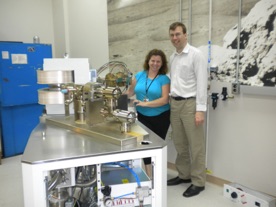
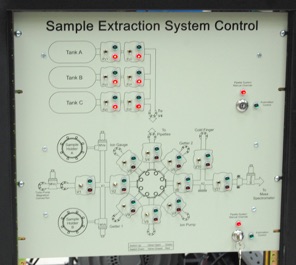
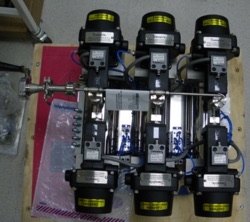
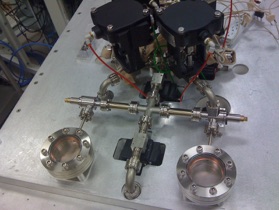
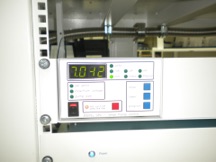
Barbara Cohen (MSFC) and John Saxton (Nu Instruments) installing Noblesse #023 in July 2010
The MNGRL laboratory consists of:
A Nu Noblesse magnetic sector mass spectrometer with a high-voltage Nier source for high-precision isotope ratio measurements, fitted with four discrete dynode ion-counting multipliers and a Faraday cup for simultaneous counting of up to five isotopes of Ne, Ar, Kr, and Xe. The Noblesse is one of the most advanced commercially available instruments, featuring a mass resolution of 3000 and 40Ar sensitivity of 6.25 x 10^19 cps/mol on the multipliers.
An ultra high vacuum (UHV) noble gas extraction system, with both manual and automatic control modes, pumped by a Varian StarCell pump, turbomolecular pump, and oil-free scroll pump. We purify gas samples using SAES SORB-AC getters. Noble gases can be separated for analysis using a Janis closed-cycle cryogenic cold trap.
Standard gas mixtures and cleaned air for standards and calibration contained within three pipettes built by ASI Scientific Instruments. Gas standards will be cross-calibrated with the JSC noble-gas laboratory. We also use laboratory-grade salts as irradiation standards and a variety of mineral standards for age determination. Our packages for 40Ar-39Ar work are irradiated at the Oregon State University’s TRIGA facility.
A FUSIONS.970 laser heating system from Photon Machines with confocal optics and two-color infrared pyrometer. The laser hovers over two laser ports with quartz windows and has fully automated positioning and power. One laser port is equipped with a thermocouple to precisely calibrate the pyrometer readings.
A fused-silica sample planchet that holds up to 150 sample packets. We plan to enclose each sample in platinum, which will allow uniform heating of the samples by the diode laser. This approach eliminated the potential for uneven coupling seen in many extraterrestial samples and also enables precise temperature determination for thermochronometry and diffusion studies.
Ultra-low vacuum (7.0 x 10-12 torr), roughly equivalent to the vacuum at 200 km in space, achieved in the MNGRL Noblesse system
Pipette system with three 2-cc pipette volumes for different gas standard mixtures for calibration
Dual laser viewports on the end of the sample extraction line
Schematic of the MNGRL Extraction Line

